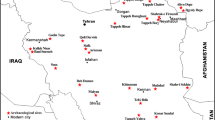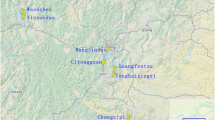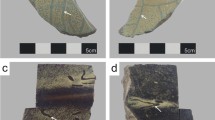Abstract
The Samnite bronze belts and the chest disk cuirasses (VIII–IV BC) are the distinctive defensive weapons of the Samnite warriors having likely also a symbolic relevance. These artefacts were mainly found during the archaeological excavations of warriors’ graves from ancient Abruzzo (central Italy). Their chemical composition, metallurgical features and corrosion products formed during the long-term burial have been studied by means of the combined use of analytical techniques such as optical microscopy (OM), scanning electron microscopy coupled with energy-dispersive X-ray micro-analysis (SEM–EDS), X-ray photoelectron spectroscopy (XPS) and X-ray diffraction (XRD). The micro-chemical and structural results show that the bronze belts have often been produced by using unusual high-tin bronze alloys achieving a silver-like appearance and by performing tailored cycles of thermal treatments under reducing conditions and hot mechanical working aimed to shape the high-tin alloys in the form of a thin bronze sheet. Furthermore, the investigation has shown that the main alloying elements have been transformed during the burial into mineral species giving rise to the formation of stratified structures constituted by different mineral phases such as tin oxides, cuprous oxide (Cu2O) and copper carbonates (azurite (Cu3(CO3)2(OH)2 and malachite (CuCO3Cu(OH)2)) as well as dangerous chlorine-based compounds such as nantokite (CuCl) and atacamite (Cu2(OH)3Cl) polymorphs. This information evidences the strict interaction of the alloying elements with the soil components as well as the occurrence of the copper cyclic corrosion as a post-burial degradation phenomenon. The present study confirms that the combined micro-chemical and micro-structural investigation techniques such as SEM–EDS, XPS, XRD and OM can be successfully used to investigate the technological production processes of the ancient artefacts and to achieve the detailed micro-chemical and structural description of the corrosion products useful for the identification of degradation agents and mechanisms and, thereafter, to propose a reliable tailored strategy for the conservation.









Similar content being viewed by others
References
E.T. Salmon, Samnium and the Samnites (Cambridge University Press, Cambridge, 1967)
G. Tagliamonte, I Sanniti (Longanesi, Milano, 1996)
M. Suano, Sabellian–Samnite Bronze Belts in the British Museum. Occas. Pap. - Br. Mus., vol. 57 (British Museum Press, London, 1986)
M. Romito, I Cinturoni Sannitici (Electa, Naples, 1995). Book series published by the Direzione dei Musei Provinciali e del Centro ‘Nicola Cilento’ per l’Archeologia Medioevale dell’Università degli Studi di Salerno. ISBN 8843548271
G.M. Ingo, E. Angelini, T. de Caro, G. Bultrini, Appl. Phys. A, Mater. Sci. Process. 79, 171 (2004)
D.A. Scott, in Metallography and Microstructure of Ancient and Historic Metals (The Getty Conservation Institute, Malibou, 1991), p. 25
D.A. Scott, Copper and Bronze in Art, Corrosion, Colorants, Conservation (The Getty Conservation Institute, Malibou, 2002)
L. Robbiola, J.-M. Blengino, C. Fiaud, Corros. Sci. 40, 2083 (1998)
D.A. Scott, Stud. Conserv. 30, 49 (1985)
D.A. Scott, J. Am. Inst. Conserv. 29, 193 (1990)
C.G. Fink, in The Corrosion Handbook, ed. by H.H. Uhlig (Wiley, New York, 1948)
F. Schweitzer, in Proc. Symp. Organised by the Paul Getty Museum, ed. by D.A. Scott, J. Podany, B.B. Considine (J. Paul Getty Museum, Malibou, 1994), pp. 1–20
G. Padeletti, G.M. Ingo, A. Bouquillon, S. Pages-Camagna, M. Aucouturier, S. Rohers, P. Fermo, Appl. Phys. A, Mater. Sci. Process. 83, 475 (2006)
G.M. Ingo, S. Kaciulis, A. Mezzi, T. Valente, F. Casadei, G. Gusmano, Electrochim. Acta 50, 4531 (2005)
G. Cossu, G.M. Ingo, G. Mattogno, G. Padeletti, G.M. Proietti, Appl. Surf. Sci. 56–58, 81 (1992)
G.M. Ingo, G. Padeletti, Surf. Interface Anal. 21, 450 (1994)
G.M. Ingo, G. Marletta, Nucl. Instrum. Methods Phys. Res. B 116, 440 (1996)
G.M. Ingo, E. Angelini, T. de Caro, G. Bultrini, I. Calliari, Appl. Phys. A, Mater. Sci. Process. 79, 199 (2004)
G.M. Ingo, T. de Caro, C. Riccucci, S. Khosroff, Appl. Phys. A, Mater. Sci. Process. 83, 581 (2006)
P.T. Craddock, J. Archaeol. Sci. 3, 93 (1976)
P.T. Craddock, J. Archaeol. Sci. 4, 103 (1977)
P.T. Craddock, J. Archaeol. Sci. 5, 1 (1978)
A. Butts, Copper, the Science and Technology of the Metal, Its Alloys and Compounds. A.C.S. Monogr. Ser., vol. 12 (Reinhold, New York, 1954)
M.B. McNeil, B.J. Little, J. Am. Inst. Conserv. 10, 186 (1999)
N.D. Meeks, Archaeometry 28, 133 (1996)
G.M. Ingo, L. Giorgi, N. Zacchetti, N. Azzerri, Corros. Sci. 33, 361 (1992)
E. Paparazzo, G. Fierro, G.M. Ingo, N. Zacchetti, Surf. Interface Anal. 12, 438 (1988)
R. Schlesinger, H. Klewe-Nebenius, M. Bruns, Surf. Interface Anal. 30, 135 (2000)
V. Hayez, A. Franquet, A. Hubin, H. Terryn, Surf. Interface Anal. 36, 876 (2004)
D. Chadwick, T. Hasemi, J. Electron Spectrosc. Relat. Phenom. 10, 79 (1997)
R.F. Roberts, J. Electron Spectrosc. Relat. Phenom. 4, 273 (1974)
C.D. Wagner, A. Joshi, J. Electron Spectrosc. Relat. Phenom. 47, 283 (1988)
C.D. Wagner, Auger chemical shifts and the Auger parameter, in Practical Surface Analysis by Auger and XPS, ed. by D. Briggs, M.P. Seah, 2nd edn. (Wiley, New York, 1990). Appendix 4
P. Lucey, Br. Corros. J. 7, 36 (1972)
W.A. Oddy, N.D. Meeks, in Proc. Conf. Science and Technology in the Service of Conservation, Washington, 3–9 September 1982, p. 119
Acknowledgements
The activities have been performed in the framework of the bilateral project between Italy (Soprintendenza per i Beni Archeologici dell’Abruzzo, Ministero per i Beni e le Attività Culturali) and Confederation Helvetique for the protection of cultural heritage.
Author information
Authors and Affiliations
Corresponding author
Rights and permissions
About this article
Cite this article
Riccucci, C., Ingo, G.M., Faustoferri, A. et al. Micro-chemical and metallurgical study of Samnite bronze belts from ancient Abruzzo (central Italy, VIII–IV BC). Appl. Phys. A 113, 959–970 (2013). https://doi.org/10.1007/s00339-013-7723-2
Received:
Accepted:
Published:
Issue Date:
DOI: https://doi.org/10.1007/s00339-013-7723-2




